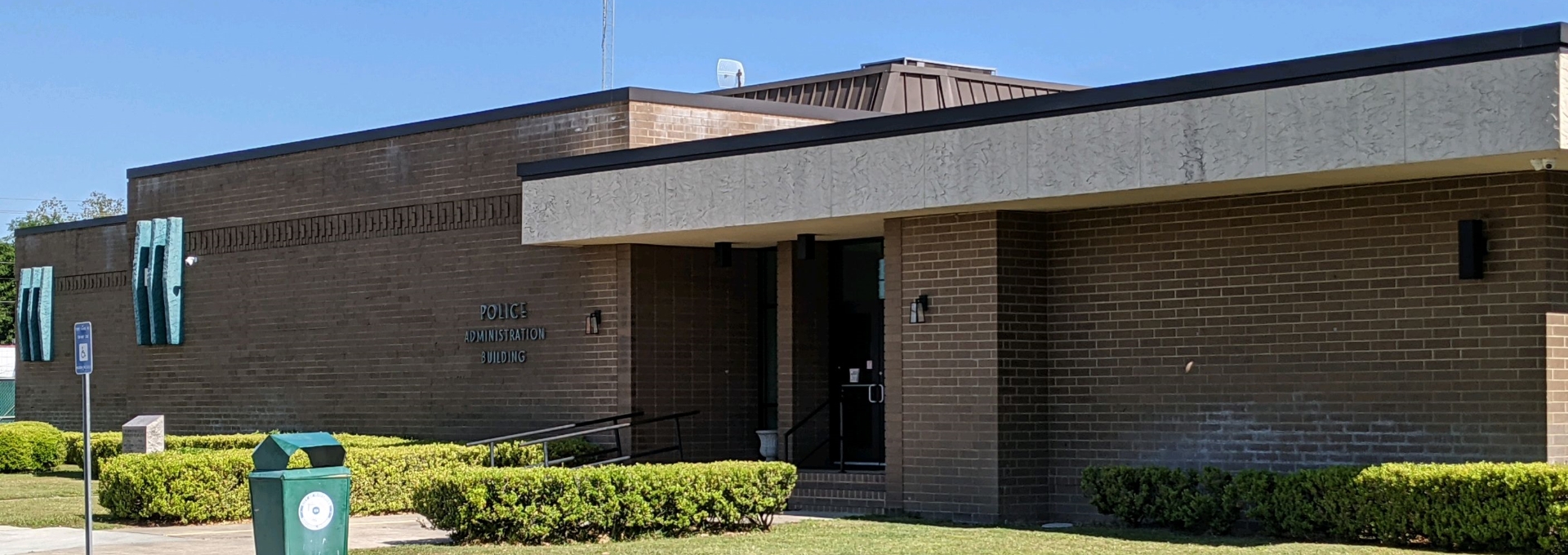Waycross Police Department History
History
While the City of Waycross was incorporated in 1874, it was not until some ten years later that we find any reference to the first recorded moves toward law enforcement. It was in 1884 when S.F. Miller became Waycross’ first police officer as he was sworn in as town marshal.
Miller served in multiple capacities as the Town Marshal, the Chief of Police, and as the City Tax Collector. For five years after his taking office, the City Council awarded him manpower assistance. Before this time, Miller was the “police force.”
In January 1889, Chief Miller’s command consisted of three policemen. They were S.G. Watson, Andrew Cobb, and H.E. Thompson. The City Council also voted an ordinance requiring all regular policemen and the marshal to wear police uniforms when they were on duty. This, then, was apparently Waycross’ first step in the formation of a regular working police force.
The following year, 1890, the positions of City Marshal and that of Chief of Police were, for the first time, separated by the City Council. S.F. Miller retained the job as City Marshal and Officer S.G. Watson became the first full-time Chief of Police in Waycross. The council also allotted the new Chief his own three-man force comprised of J.M. Colley, T.M. Westberry, and E.M. Cason.
Watson’s position was short lived. Only one month after his appointment as Chief of the Waycross Police Department, the City Council abolished Watson’s office and the duties that belonged to the Chief of Police reverted to the City Marshal.
Miller remained the City Marshal for three more years. In 1894, W.K. Sweat replaced him, holding the job as City Marshal until 1897. At that time, Miller again became the City Marshal and stayed in the office until 1898.
Thereafter, five times in the history of the City has the position of Chief of Police been abolished and reinstated by the City Council. On each occasion the duties of the Chief of Police were given to the City Marshal. Three times in the history of the City of Waycross has the positions of Chief of Police and Fire Chief been incorporated and separated. This was first in 1925, again in 1932, and last in 1935. Each time, Chief H.C. Thackston held the titles. It is probable that the reason for these latter moves were basically economic as the nation was then in the grip of the Great Depression and the city treasury was often strained.
Those men who served throughout the years in the combined offices of the City Marshal and Chief of Police were: W.K. Sweat, 1894-1897; J.W. Colley, 1899-1901 and 1905-1925; John W. Lee, 1902-1904; and C.F. Justice, 1928-1929.
There have been only 14 men in the history of Waycross who have served in the capacity only as Chief of Police.
They were:
- N.J. McClellan, 1906
- F.B. McDonald, 1910-1911 and 1930-1932
- E.L. Davis, 1934
- W.A. Yawn, 1936-1942
- R.I. Morgan, 1943-1946
- J.G. DeLoach, 1947-1951
- A.L. Ball, 1952-1958
- J. Lonnie Murphy, 1959-1961
- Ray Pope, 1962-1969
- Herbert Bond, 1970-1978
- W. Lynn Taylor, 1978-2001
- James E. Blackburn, 2001-2005
- Anthony H. Tanner, 2005-2019
- Tommy A. Cox, 2019-present
W. Lynn Taylor, 1978-2001, has been the only Public Safety Director the Waycross Police Department has ever had. Taylor served as the Public Safety Director for the Fire Department and as Chief of Police.
It was during these early years that the first semblance of a police department began to emerge. The initial attempts to form an effective law enforcement unit were faltering and clumsy. The requirements for police officers at that time were low. The relative position of the law enforcement officer to the remainder of the community may best be exemplified by his marginal income and the fact that even though most farm hands got one day per week off, the police officer was forced to work seven days a week and 12 hours per day. It was not until the 1920s that the police officer was first allowed one day off per week.
Improvements came slowly. Years later the working day of the police officer was shortened to eight hours, but the six-day week lasted until about 1969. That year, the schedules gave each man two days off on alternate weeks. In early 1970, the department went to the 40-hour work week.
In 1970, Georgia passed a minimum requirement for state and local law enforcement personnel which demanded that anyone hired in law enforcement had to have at least a high school education and attend 114 hours of mandatory police training.
The Waycross Police Department had been sending its personnel to the Georgia Police Academy for this training for about two years prior to the Georgia law; the new law was requiring a written examination, physical examination, and background security clearance.
By 1971, drugs were becoming a problem in Waycross. Community pressure to form a special unit in the police department to fight the problem resulted in one of the first drug enforcement squads in the area. Controversy plagued the unit almost from the start, as drugs were then, as now, a subject invoking passions both pro and con.
Federal funding helped in the creation in 1970 of a traffic enforcement unit. Again, Waycross was the only city of its size in the area to have such a unit.
In 1974, the newest addition to the department was the Crime Prevention Unit, whose job it was to work with the community in creating more awareness on the part of the citizenry about the crime picture in Waycross and to solicit the community assistance in prevention of crime.
It may be of interest that in 1975, when the nation experienced an 18% increase in crime, the new methods and tactics of the Waycross Police Department helped to account for a one percent decrease in the crime rate.
It can therefore be concluded that the development of law enforcement in Waycross did not significantly start before the federal influence and social changes of the 1960s, and that further positive development probably is dependent to a great extent on continuance of this federal assistance in conjunction with responsible, able leadership.
A large portion of the information here came from a paper written by Donald Sparry titled:
“The Development of Law Enforcement in a Small Southern Town.”
In Memory
Captain
Pierce W. Farr
Captain Farr was mortally wounded by Matthew Milton and Patrolman Coggins was seriously wounded in a flurry of gunfire on Walter Street just off Gilmore Street Sunday morning about 2:15 o’clock. Pierce W. Farr, 46, Captain of the Waycross Police Department for 16 years, died in a local hospital four and a half hours after he sustained an abdominal wound.
Funeral services were held April 12, 1944 at Trinity Methodist Church. Pallbearers were W.W. Shackleford, C.T. Myers, J.G. DeLoach, W.C. Hughes, Branch Cullens, and Mayes Bownton and honorary pallbearers included members of the police department and members of the military police who had been associated with Capt. Farr at local police headquarters.
Taps were sounded over the grave to conclude the rites. There were many beautiful floral tributes.
Capt. Farr was a World War I veteran, with foreign service, and also a member of the Elks and the Woodmen of the World.
He was survived by his wife, the former Miss Mary Williams of this city; a 13-year-old son, Robert, and a young daughter, Mary Anne; also his mother, Mrs. Flora Farr of Waycross; two brothers, Q.B. Farr of Allendale, SC, and Francis Farr of Wilmington, NC, and three sisters, Mrs. Elizabeth Gornto of Waycross, Mrs. Martin Holt of Waycross and Mrs. C.H. Moore of New Orleans.
Patrolman
William Carter Coggins
April 10, 1944, Matthew Milton, assailant, was shot to death at the jail door after killing Waycross Police Captain Farr (above) and wounding patrolman Coggins while the officers were transferring him to the Pierce County Jail. Sheriff Carter said the two Waycross officers and a state patrolman brought Milton here last night about 10 o’clock, for safe-keeping. Carter said that Milton drew an ice pick from his clothing as he was being removed from the police car and attacked the officers. The officers shot at him three times, the sheriff reported. Capt. Pierce W. Farr of the Waycross police department was shot and killed and Patrolman Bill Coggins was critically wounded.
Officer Coggins, who has had several years of service as a patrolman, lost his sight as the result of a load of Number 6 shot sprayed in his face and head from a range of about 15 feet.
Police Officer
Walter Brakes
Police Officer Walter Brakes of the Waycross Police Department was shot and killed in the line of duty on August 27, 1920. Officer Brakes made a raid at the hotel known as Ford’s Place on Reed Street about 01:30 hours where he was met by a subject who was intoxicated and armed. The suspect pulled a pistol and the suspect and officer were both shot almost simultaneously.
Officer Brakes received a fatal wound to the chest and died almost instantly. The suspect, who also was wounded, died later while in the Chatham County Jail.

